कुल्लू घाटी के सब्जी उत्पादकों के लिए शिमला मिर्च या कैप्सिकम में रोग प्रबंधन का मासिक कार्यक्रम
Kullu valley in Himachal Pradesh is known for off season cultivation of vegetables. Capsicum (commonly known as Shimla Mirch) cultivation has gained popularity in the valley as an off-season vegetable crop fetching remunerative price in markets.
Its cultivation is being taken up by farmers in summer-rainy season as poly house and open field crop. Depending upon an area, its nursery sowing begins in the months of March (Kullu) to April (Katrain) and transplanting in April to May that extend its cropping period up to September in open field conditions and February in polyhouse conditions of the valley.
It is readily available in the local market almost from June to Feb and also transported to distant markets as well in the neighboring states.
For past few years, diseases like Phytophthora leaf blight , fruit rot, wilt and bacterial blight have attained alarming proportions causing severe yield loss in the region. Besides, dieback, anthracnose, sun scald and blossom end rot are also affecting quality capsicum production in the valley.
The symptoms and critical period of occurrence of economically important capsicum diseases along with their monthly management schedule from sowing to harvest are described and discussed in the article. This information may be utilized for timely diagnosis and monitoring to take up preventive and curative disease management measures by the stakeholders.
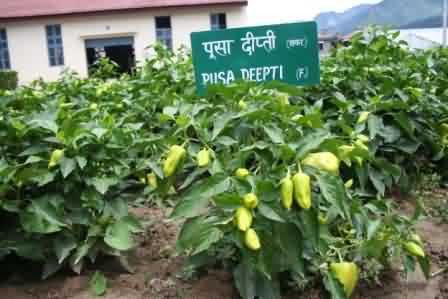 Capsicum disease management in March-April
Capsicum disease management in March-April
Mid March to April is the time of raising capsicum nursery in Kullu valley. Damping-off and root rot are the most commonly observed nursery diseases in the region. Besides, infection of seed borne diseases like bacterial leaf blight, viral diseases and anthracnose persists and remain latent in nursery, whose severity increases in main field on arrival of favorable conditions.
Management practices:
- Capsicum sowing in nursery should be done during mid march to April so as to raise healthy crop. Delayed sown crop is likely to suffer from blight and fruit rot diseases.
- In endemic areas of the valley, where diseases are known to recur year after year, pesticide control becomes economically unviable. In such areas, it is advised to choose resistant hybrids or cultivars. IARI Regional Station has released bacterial leafspot (Xanthomonas vesicatoria) and anthracnose (Colletotrichum capsici) tolerant hybrid, Pusa Deepti (Fig.1) for cultivation in western Himalayan zone. It is a prolific fruit bearer with average yield of 35-45 tonnes/ha.
- Avoid bell pepper cultivation in field where solanaceous crop like tomato, potato and brinjal are previously cultivated as this will aggravate wilt problem.
- Certified Seed procured from reliable suppliers with proper bill mentioning variety/ hybrid name should be used for sowing. Grade out if any discolored seeds before sowing.
- Look for seed treatment if any by supplier on seed label, in case it is not pretreated, dry treat seed with Captan 50WP@ 2g/kg seed.
- Always raise nursery in pro-trays. If it is to be sown in nursery bed, ensure proper density as densely sown seedlings get predisposed to damping off and toppling. To protect from rains, nursery beds may be covered with UV stabilized corrugated or plain fiber reinforced plastic sheet tunnels supported on metallic frame in a semicircular shape.
- The nursery media may be enriched with Trichoderma viride @ 1kg/100 Kg nursey media 15-20 days before sowing.
- Do spot application of Captan (0.2%) solution as drench in nursery to manage damping off.
Capsicum disease management in May
Capsicum is transplanted in main field during this month. Wilt diseases are commonly noticed post transplanting in transplants with injured young roots that get easily infected by wilt pathogen from soil.
Management practices:
- To ensure no fungal disease and aphids are carried out to main field from nursery, one week prior to transplanting spray nursery with fungicide Carbendazim 50 WP (Bavistin) @ 1g/litre and insecticide Dimethoate (Rogor) @1.7ml/litre.
- Utmost care should be taken to select only healthy vigorous seedling for transplantation to main field. One week before transplanting, harden-off seedlings by restricting fertilizer and irrigation.
- The best time for transplanting capsicum in upper kullu valley is between first to third weeks of May. Crop transplanted in this period records low disease incidence and high yield.
- Follow planting on raised beds with proper drainage to protect from wilt and blight diseases.
- Practice earthing up 25 days after transplanting, delayed earthing up damages roots and predisposes crop to wilt diseases.
- Drench soil around wilted & adjoining plants with 0.3 % blitox solution.
Capsicum disease management in June
During first fortnight of June, Alternaria blight appears both on leaves and growing tip to cause dieback. The disease can be identified by the presence of characteristic concentric rings on leaves. It reaches peak intensity during second fortnight of June with prevailing high temperature.
Die back symptoms associated with Colletotrichum, Cercospora and Alternaria, is noticed during second fortnight. Twigs get blighted; purplish black streaks starts appearing on stem associated with yellowing of leaves. Plants with viral infection showing mosaic symptoms on leaves are also noticed during this period.
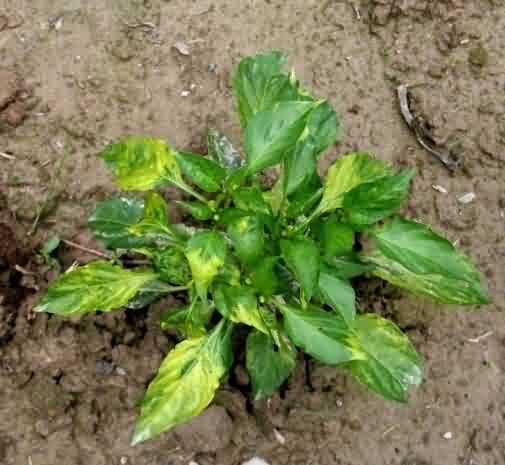
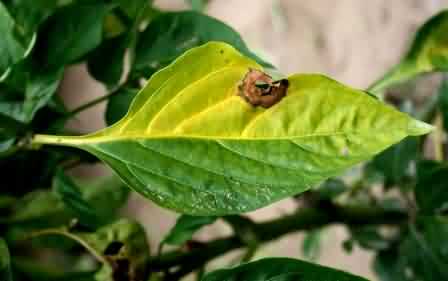
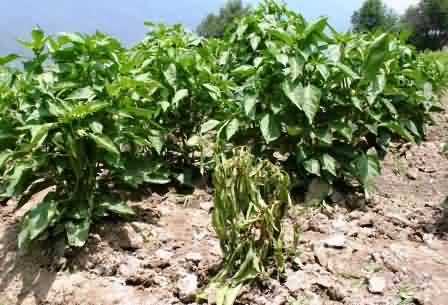
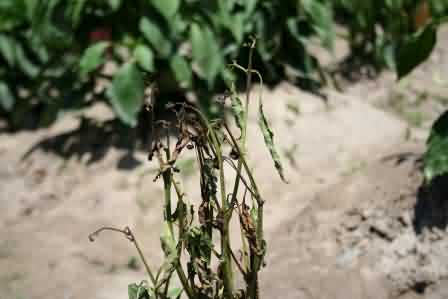
During second fortnight, dieback disease aggravates (Fig.4) and maximum wilt incidence is noticed in the field after intermittent showers received post intercultivation (Fig.5).
Management practices:
- Take foliar spray of Chlorothalonil 72 WP (Kavach) 0.2% in the first week to manage alternaria. Give alternate spray of DM-45 (Mancozeb) after 15 days to manage foliar disease complex and dieback caused by Alternaria,Colletotrichum and Cercopspora.
- Periodically monitor for incidence of viral diseases, remove and destroy infected plants as soon as sighted in the field to prevent further spread.
- Scout for the presence of insect aphids. To manage them, spray Dimethoate (Rogor) 17.5 EC @ 1.7 ml/litre or Imidachloprid 17.8 SL (Confidor) @ 0.5ml/litre.
- Drench wilted and surrounding plants with blitox solution (3ml/litre).
Capsicum disease management in July
July is the critical month for monitoring and taking prophylactic measures against bacterial blight, sunscald and blossom end rot. During this period, Alternaria black spot declines and gets confined to older leaves. The new flush remains free of the disease. Unattended dieback and wilt affected plants wilt completely by this time.
High sun intensity and hot weather in mid of July month causes sunscald on fruits. White papery area appears on fruit, which gets eventually colonized by secondary fungi which turn to black with powdery masses (Fig.6). Its incidence is more in plants defoliated by foliar diseases.
With prevailing high temperature and humidity, bacterial leaf spot appears on leaves and progress severely in second fortnight. The most diagnostic symptom is the presence of dark, water soaked, greasy-like angular lesions on leaves (Fig. 7). Lesions on fruits render the produce less marketable.
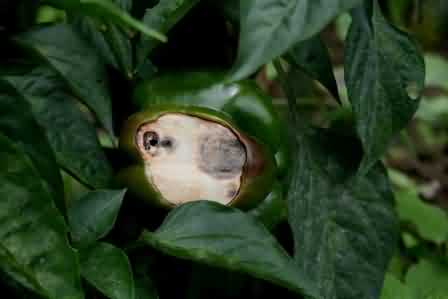
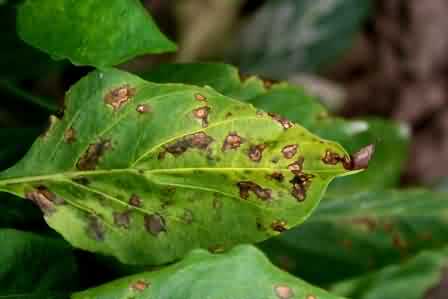
Blossom end rot disorder is noticed in first two fruit setting period, in July month. Dry sunken decay (Fig.8) from blossom end of the fruit makes the fruits unmarketable.
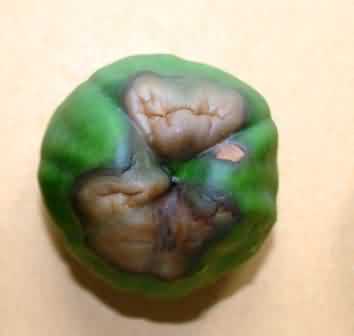 Management practices:
Management practices:
- Spray crop with Copper oxychloride 50WP (Blitox) 3g/ litre in the second week of July, followed by Streptocycline (1g/10 litre) + Copperoxychloride 50WP (3g/litre) at 7-8 days interval to check spread of bacterial spot.
- Apply Calcium Nitrate as spray @ 3 g/ litre in the first week and repeat the same after 15 days to prevent blossom end rot and sunscald.
- Avoid excess N application and moisture stress as it predisposes capsicum to Blossom end rot.
- Never mix micronutrients with pesticides in a single spray.
- Spray Carbendazim 50WP @ 1g/litre on foliage and fruits to prevent secondary infection of sunscald fruits.
- Add sticker (wetting agent) @0.5 ml/ litre to spray solution to ensure pesticide adherence on leaves in all pesticide sprays.
- Do not allow water to stagnate in field as it increases disease incidence.
Capsicum disease management in August
With monsoon showers and prevailing cool temperature, brightened tan coloured lesions (Fig.9) starts appearing on leaves near soil line indicating the arrival of Phytophthora leaf blight and fruit rot in the beginning of the month.
The disease is common to observe in fields with poor drainage. As disease proceeds, fruits tend to be water soaked initially, subsequently followed by rotting (Fig.10) by mid of the month if proper control measures are not taken. It is the most devastating diseases of Capsicum in Kullu valley.

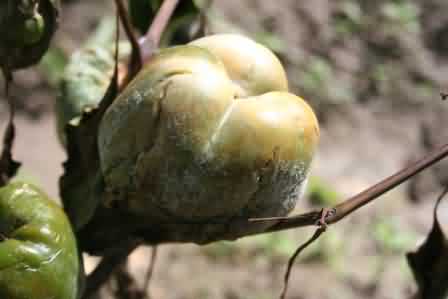
Management practices:
- Maintain proper water drainage in fields, to prevent spread of leaf blight & wilt diseases.
- Give prophylactic spray of DM-45 @ 2.5 g/liter in the first week
- Remove blighted leaves and fruits near soil line before fungicide spray. Dispose it by deep burying and drenching with blitox solution.
- Spray Curzate or Ridomil mz @2.5g/litre in second week. Harvest at regular interval on maturity, delayed harvest harbors pathogens on fruits that serve as reservoir of inoculum for disease spread on sporulation.
- During last week, spray Dimethomorph 50 WP @ 1g/liter along with sticker/wetting agent @0.5ml/litre.
- Always take sprays after harvesting fruits and removing infected plants, this practice will reduce inoculum load and pesticide residue in fruits.
- Add sticker/wetting agent Indtron AE or Sandovit @ 0.5ml/litre to spray preparation in all sprays during the month.
Capsicum disease management in September-October
Majority of crop cultivated for vegetable purpose is harvested by September end, but late transplanted crop remains in the field up to October. Low temperature and rain showers make fruit to rot due to phytophthora and other fungal infection in early September.
In second fortnight of September, Powdery mildew initiates on foliage as yellow lesions on top of leaf with corresponding powdery mass on lower surface. It becomes severe by October second week with prevailing cool dry weather conditions. Entire foliage gets covered by powdery mass leading to yellowing and defoliation (Fig.11).

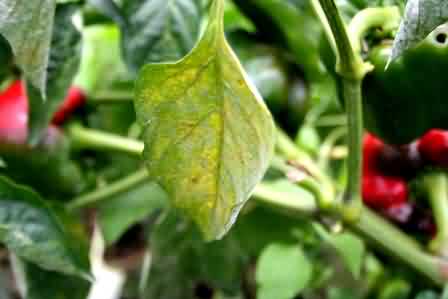
Anthracnose is the other minor disease occurring in the locality. Its lesions are noticed on foliage and fruit in October. It can be identified by the characteristic irregular leaf spot with white sporulating centre. Though the disease is not severe to cause serious damage to crop in the region, lesions on fruits render them unmarketable.
Management practices:
- Spray hexaconazole 5% EC (Contaf) @1ml / litre along with sticker @ 0.5ml / litre to control powdery mildew.
- Take curative sprays with contact fungicides DM-45 or Chlorothalonil 75 WP(Kavach) 2 .5 g / litre to manage anthracnose and leaf blight
- Follow field pea or Cole crop based cropping pattern in rabi to restore soil fertility and reduce soil borne inoculum that are carried to next pepper season.
Adoption of the suggested management practices throughout capsicum growing period would certainly help control the various biotic and abiotic stresses being faced by the farmers of the region and ensures the quality capsicum production.
Disclaimer: Brand name of pesticides mentioned in the article are indicative and for general understanding of farmers. The authors and the institution affiliated do not endorse any of the commercial products.
References:
- Amrik Singh Sidhu. 2011. Protected cultivation of capsicum.Indian Institute of Horticultural Research, Hessaraghatta lake Post, Bangalore.
- Gangopadhyay, S.1984. Advances in vegetable diseases. Associated publishing company, New Delhi, pp643.
- Jaya Chaudhary and Banyal, D. K. 2013. Status and distribution of Phytophthora leaf blight and fruit rot of capsicum in Himachal Pradesh and its management through fungicides. Indian Phytopathology, 66(2):135-139.
- Shailendra Kumar.2012.Integrated Pest Management schedules for vegetables. Technical bulletin No 6. National Horticultural Mission, Department of Agriculture & cooperation, Ministry of Agriculture, New Delhi.
- Verma T.S. 1999.50 years of vegetable research and development. Indian Agricultural Research Institute, regional Station, Katrain, Kullu Valley, Himachal Pradesh, India.
- Verma LR and Sharma RC.1999.Diseases of horticultural crops vegetables, ornamentals and mushrooms. Indus Publishing Company, New Delhi
Authors:
Sandeep Kumar, G.M, Vinod Kumar Sharma and Prasannakumar N.R,
IARI Regional Station, Katrain 175 129, Kullu Valley, Himachal Pradesh, India.
Email:
